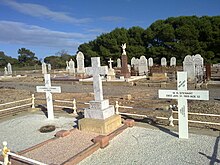SS Clan Ranald (1900)
SS Clan Ranald is a steamship wreck off the coast of South Australia that is of unique historic importance.William Doxford & Sons in England built her in 1900 for Clan Line, which operated the largest fleet of turret deck ships in the World.[16] At 1400 hrs Clan Ranald was south of Troubridge Island when suddenly her starboard list increased to 45 degrees.Clan Ranald's crew sighted another steamship, British India SN Co's Uganda, nearby, so they fired distress rockets.Some of her crew were drowned as she sank, and others died of injuries or cold while trying to swim to the shore, which consisted of cliffs and jagged rocks.The officers were accommodated in Woodcock's Royal Arms Hotel, and the lascars were held in the basement of the Prince Alfred Sailors' Home.[19] Under the White Australia policy, each lascar's hand print was taken and he was given a dictation test, which was rigged to ensure all 20 of them failed.On the centenary of the shipwreck, 31 January 2009, a monument was installed on the mass grave recording the names of the 34 lascars who died, including those whose bodies were either not found or not identified.Uganda's Master, Captain Kilpatrick, was asked why his ship did not come to help when Clan Ranald fired distress rockets.[27] Volunteers from the South Australian Museum Underwater Historical Research Group rediscovered the wreck in 1962.However, since the advent of recreational scuba diving in the 1960s, divers have looted non-ferrous metal from the wreck such as copper pipes from her boilers and personal artefacts.Clan Ranald's manifest is rumoured to have been recovered from the beach shortly after she sank, and is said now to be privately owned by a resident of Edithburgh.[28] Despite the large amount of wreckage, South Australia's Department for Environment and Water (DEW) classifies the site as poorly preserved.[31] The environmental state of the site is stable, and the DEW considers the wreck to be at low risk from natural damage.[28] Clan Ranald is notable both for its high loss of life and its unique place in Australian maritime archaeology.In 1909 a poet called Archibald Deacon wrote about the loss: Down the Port River, on a mid-summer day The steamer, Clan Ranald, swept proudly away.[citation needed] One of Clan Ranald's anchors was recovered by the crew of a vessel called the Para Star.In 1975 it was mounted as a monument on the cliffs near where the ship sank, with a plaque recording both the loss of Clan Ranald and the recovery of the anchor.Clan Ranald is a major feature of the DEW's "Investigator Strait Shipwreck Heritage Trail".






United KingdomClan Macdonald of ClanranaldClan LineCayzer, Irvine & CoGlasgowWilliam Doxford & Sonsofficial numbercode lettersturret deck shipschoonersister shipsteamshipSouth Australiacargo shipYorke PeninsulafederalUnderwater Cultural Heritage Act 2018Charles Cayzerrefrigerated cargomotor shipUnion-Castle LineSuez CanaltonnagesregisteredMauritiusPort AdelaidebunkersstarboardSouth AfricaMasterCaptainlascarsManilaPhilippinesCalcuttaBritish IndiaTroubridge IslandTroubridge HilllifeboatsBritish India SN Co'sdistress rocketsChief OfficerThird OfficerSecond EngineerEdithburghWhite Australia policydictationillegal immigrantsImmigration Restriction Act 1901Huddart, ParkerMelbourneAdelaideColomboCeylonsovereignsChief Stewardmass graveTroubridge Island Lighthousesignal lampballast tanksseacocksSouth Australian Museumsalvagedscuba divingferrousboilersmanifestwindlassrudderDepartment for Environment and WaterartefactsAnchorsmaritime archaeologyFederal ParliamentHistoric Shipwrecks ActParliament of South AustraliaTroubridge Hill Aquatic ReserveGovernment of South AustraliaUnderwater Cultural Heritage ActEvening StandardSouth Australian RegisterAustralasian Underwater Cultural Heritage DatabaseAttorney-General's DepartmentUniversity of AdelaideDepartment of CustomsNational Archives of AustraliaDepartment of Environment and Natural ResourcesBoard of TradeSouthampton City CouncilLoney, JackLloyd's RegisterInternet ArchiveYouTubeRecreational dive sitesAkumalAliwal Shoal Marine Protected AreaAliwal ShoalAmed (Bali)Apo IslandApo ReefArrecifes de Cozumel National ParkBay of PigsBelize Barrier ReefBiscayne National ParkBohol SeaBowie SeamountBunakenBunaken National ParkCahuita National ParkCalve IslandCapurganáĊirkewwaCliff Villa PeninsulaCozumelDhilba Guuranda-Innes National ParkEdmonds Underwater ParkEl Ikhwa IslandsFalse BayGħar QawqlaGili IslandsGreat Barrier ReefGreat Southern ReefGuadalupe Island Biosphere ReserveHol Chan Marine ReserveiSimangaliso Marine Protected AreaSodwana Bay